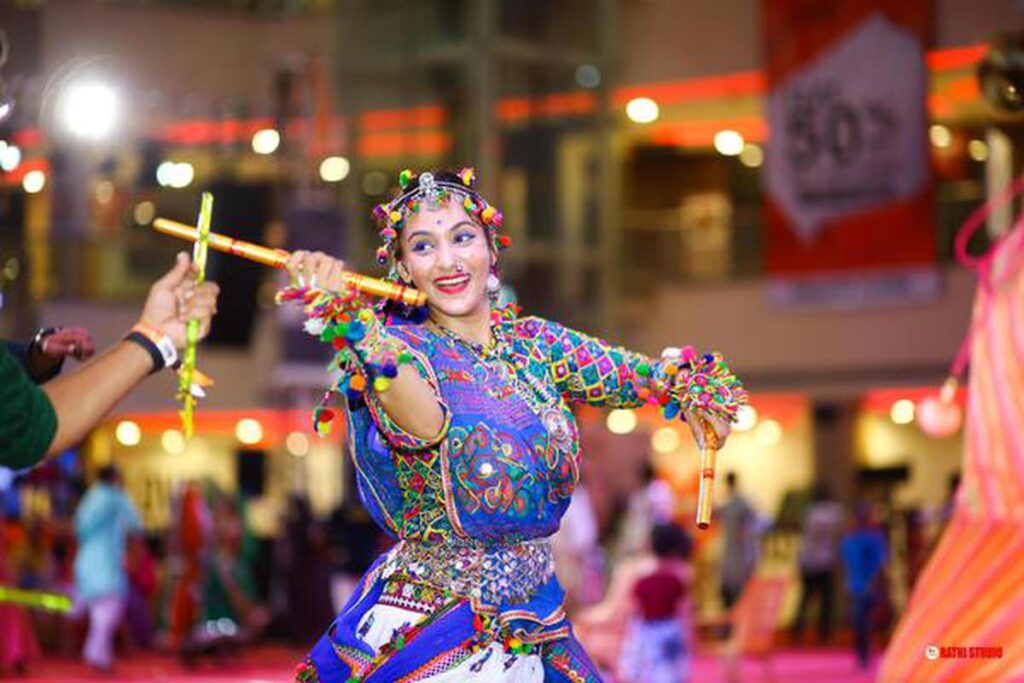
Navratri is an important festival celebrated all over India, and Goa is no different. This festival lasts for nine days and is dedicated to the goddess Durga. During this time, people in Goa come together to worship, enjoy cultural activities, and celebrate with joy.
Traditional Navratri Celebrations in Goa
Navratri in Goa begins with a ritual called Ghatsthapana. In this ritual, a pot filled with water is placed on soil, and nine different types of grains are planted around it. This marks the start of nine days of worship, fasting, and cultural events. Temples all over Goa are beautifully decorated, and people gather to pray to different forms of the goddess Durga, like Sateri, Shantadurga, and Navadurga.
One special tradition in Goa during Navratri is Makharotsav. In this tradition, the idol of the goddess is placed on a decorated wooden swing called a makhar. This is especially popular in temples like Shantadurga Temple in Kavlem, Mahalaxmi Temple in Bandora, and Navadurga Temple in Borim. The makhar is decorated with flowers, lights, and other beautiful things. During the evening aarti (prayer ceremony), the idol is gently swung on the makhar, while traditional music plays in the background.
Garba and Dandiya Nights
In addition to traditional rituals, Goa also celebrates Navratri with Garba and Dandiya nights. These are traditional dances from Gujarat, but they have become very popular in Goa as well. Garba is a dance performed in a circle, while Dandiya involves rhythmic clapping of sticks in pairs. Both dances are done to the beat of lively music, creating a joyful and energetic atmosphere.
Many clubs, hotels, and community centers in Goa organize Garba and Dandiya nights during Navratri. These events are open to everyone, making them a great way for families and friends to celebrate together. People dress up in colorful traditional clothes, with women wearing bright lehengas (long skirts) and men in kurtas. The nights are filled with music, dance, and fun, reflecting the happiness of the festival.
Cultural Programs and Competitions
Navratri in Goa is also a time to showcase talent and creativity. Many schools, colleges, and community centers organize cultural programs where people can participate in singing, dancing, and drama competitions. These events often focus on stories related to the goddess Durga and the victory of good over evil.
In some places, there are also competitions for the best-decorated makhar or the most beautifully dressed deity (idol). These contests encourage people to get involved in the celebrations and show off their artistic skills. The winners usually receive prizes, which adds to the excitement of the festival.
Fairs and Food Stalls
No festival in Goa is complete without food, and Navratri is no exception. During these nine days, many temples and community centers set up food stalls offering a variety of tasty fasting foods. These stalls serve traditional Goan snacks like sabudana khichdi (a dish made from tapioca pearls), kuttu ki poori (buckwheat bread), and singhare ki kheer (water chestnut pudding), all made from ingredients that are allowed during fasting.
In addition to the food stalls, some areas also host small fairs with games, rides, and stalls selling traditional clothing, jewelry, and handicrafts. These fairs add fun to the Navratri celebrations, making it a time for families to enjoy together.
Conclusion
Navratri in Goa is a beautiful mix of devotion, culture, and fun. The festival is celebrated with great enthusiasm, bringing people together. Whether it’s taking part in the traditional makharotsav at the temple, dancing at a Garba event, or enjoying the delicious fasting foods, Navratri has something for everyone in Goa. The vibrant celebrations show the rich cultural heritage of the state and the deep devotion of its people to the goddess Durga.


